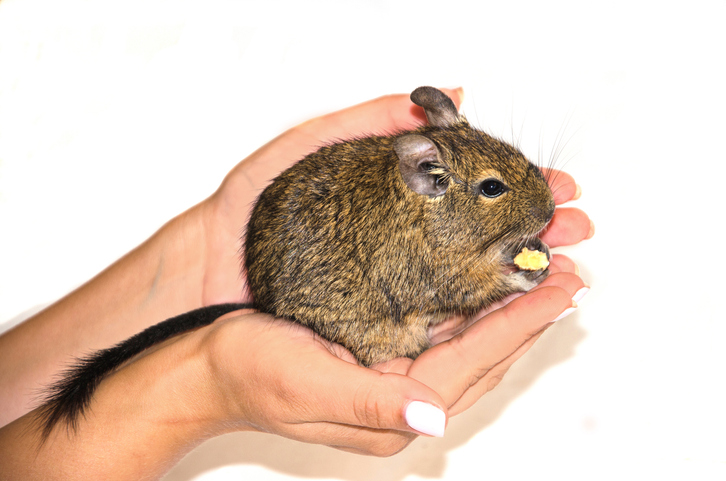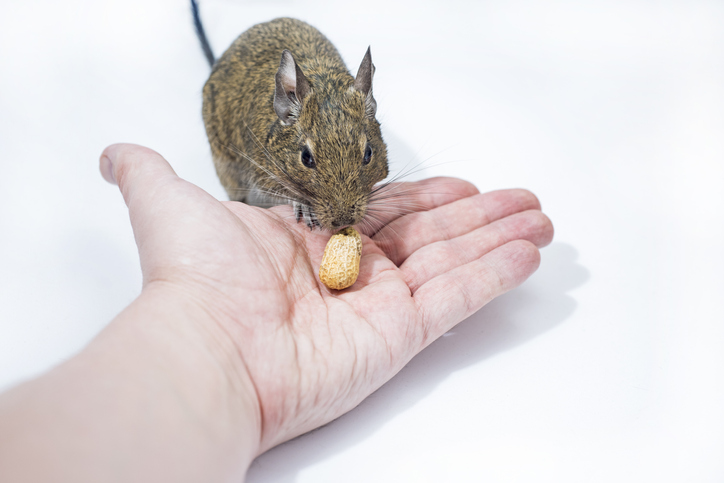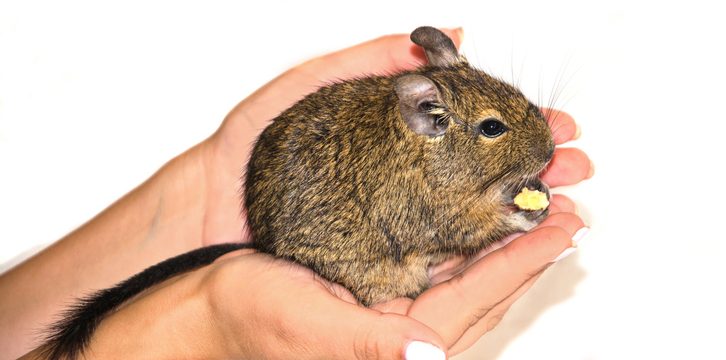Are you pet parent to a degu? These cute little rodents can make intelligent, fun family members with the right care. Whether you are new to the world of degus and are wondering ‘what does a degu look like’, or whether you’re an experienced pet parent, read on for lots of fun degu facts.
Quickfire questions
- What is a degu? A small rodent native to Chile
- How long do degu live? Five to eight years on average
- How big are degus? Adults are 15cm long, with a 15cm tail
- How much does a degu weigh? 170g – 300g
- Coat colour? Brown coat with a cream belly and paws and a tuft on the end of their tail
Now read on for a deeper delve into the world of the degu with our top five fun facts about degus.
- Degus can shed their tail when threatened
Degus are prey animals and when living in the wild, are at high risk of being eaten. This means pet degus tend to be easily frightened and like to have plenty of hideaways to retreat to when they feel anxious or threatened.
One somewhat unusual anti-predator mechanism is the ability to shed their tail in an emergency. What better way to escape a hungry predator who has grabbed you by the tail, than to simply leave it behind and continue on your way? Strictly speaking, the degu does not lose their whole tail but sheds the skin and fur covering it and so slips out of the predator’s grasp.
This defence mechanism is also seen in pet degus so never hold your furry friend by their tail. The resulting injury is very painful and tail amputation will be necessary to allow healing.

Top tips for safe degu handling
- Let your degu get used to you first – let them sniff your hands and offer treats when they approach
- Let your degu climb onto your hands when they feel comfortable to do so – this may take several weeks so be patient!
- Scoop your degu up with cupped hands
- Handle them at ground level, over a tabletop or their cage to avoid injury if they slip from your hands
- Offer a favourite treat as a reward for handling
2. Yellow teeth are a sign of health if you are a degu
Degus should have yellow teeth. In fact, white teeth can be a sign of a dietary deficiency and if you think that your degu’s teeth have become a paler colour, you should seek veterinary advice.
Similar to other rodents, a degu’s teeth grow continuously and need to be worn down when the degu gnaws and eats. Feedng plenty of high quality hay for your degu to chomp on will help keep their teeth at the correct length and in tip top condition. Are your degu’s teeth too long? If they are, you may see some of the following signs:
Signs of overgrown teeth
- Difficulty eating
- Dribbling
- Grinding teeth
- Reduced appetite
- Weight loss
- Poor coat due to reduced grooming
You may wonder how to check degu teeth for signs of dental disease. If your degu is used to being handled, you might be able to sneak a peek at their front teeth (incisors) but checking their cheek teeth requires special equipment. If your pet is showing any unusual signs or appears unwell, you should seek veterinary attention without delay.
3. Degus are at high risk of type 2 diabetes
Degus are unable to digest sugar. This means that if they are fed a diet that is high in sugar, they are very likely to develop diabetes. Sadly, there is no cure for this condition so prevention, by feeding a low sugar, high fibre diet, is the name of the game. Avoid foods that have a high sugar content which includes most fruit and some vegetables such as carrots.
If a degu develops diabetes, the condition can be managed, though never cured, with the correct diet.
Degu diabetes symptoms
The symptoms of diabetes in degus are very similar to those in other mammals, namely:
- Drinking more water
- Passing more urine
- Cloudy eyes caused by cataracts

Did you know? Degus were originally brought to the UK in the 1950s to help in the study of human diabetes
4. Degus love sand baths
After a busy day of burrowing and exploring, degus like nothing better than a good sand bath. They dislike water and trying to wash them in this way will cause them great stress. Sand or dust baths are a super-efficient way of removing dirt and absorbing oil from their coats. You should offer your pet a sand bath three times a week and your four-legged friend will appreciate a bath after being handled too.
Top tips for a successful sand bath
- Use a high-sided tray, big enough for your furry friend to have a good roll in
- Use bathing sand specifically designed with small pets in mind
- 10 to 20 minutes is usually enough, any longer and their skin and coat may dry out
- Change the sand at least once a week
5. Degus are very vocal
Degus have an elaborate repertoire of noises, using somewhere in the region of fifteen different sounds to communicate. Next time your degu starts chatting to you, see if you can work out what they are trying to tell you. Here are a few translations to start with:
- Chattering teeth – a grinding noise which signals annoyance
- Squeaks – a rapid succession of squeaks means your furry friend may be scared
- Chirping – a warbling or chirping sound can be a sign of contentment
- Squeaking – a degu that is in pain will squeal or squeak
- Chitter – ‘hello’ in degu language. Used to communicate with both humans and degus
That concludes our fun facts about degus article. For more small pet advice, why not have a read of How to keep your small pets cool this summer – Vital Pet Club
Be sure to head over to our Facebook and Instagram pages to join the Vital Pet Club!


